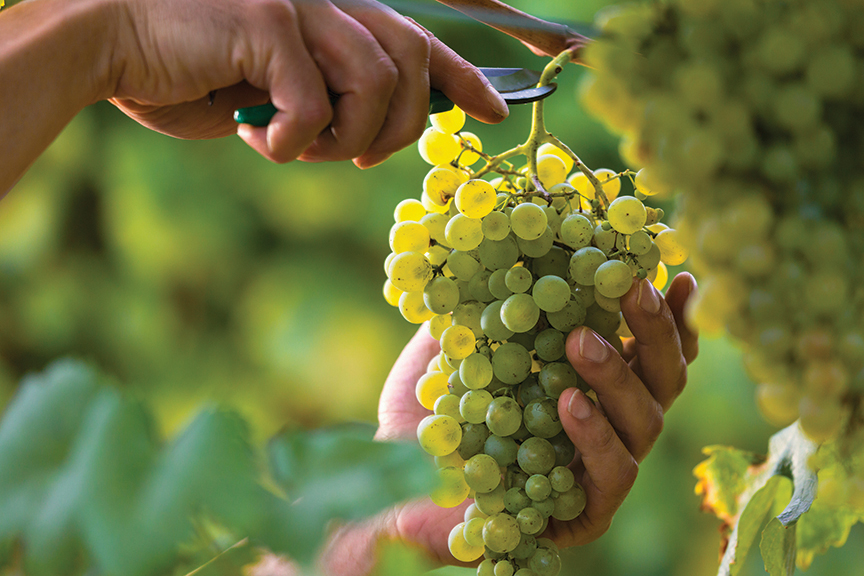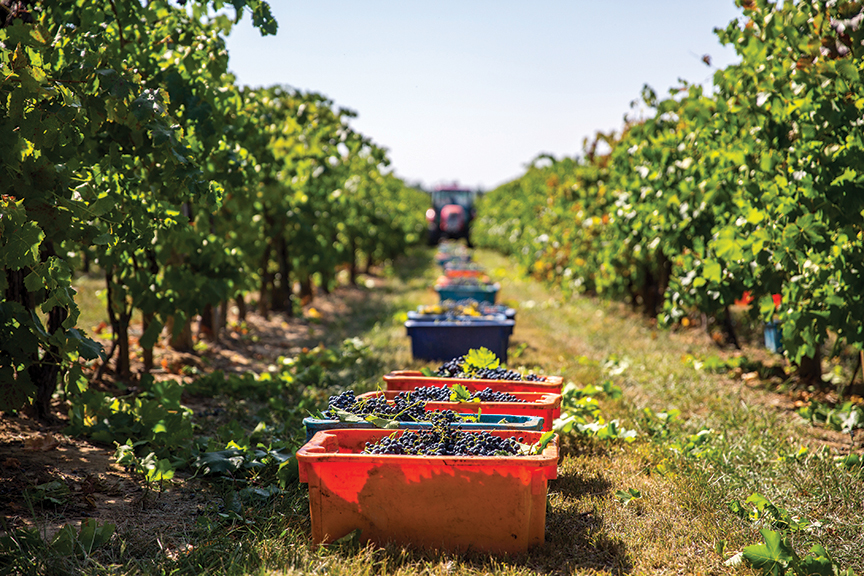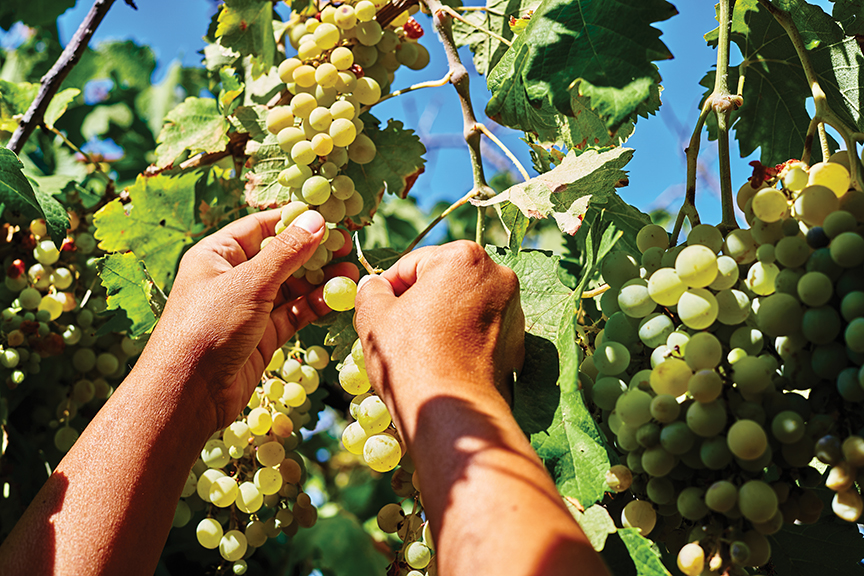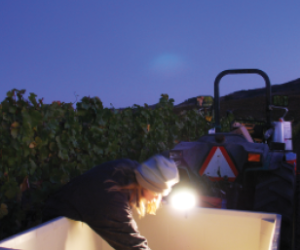There is no more critical step in winemaking than picking at the often-fleeting correct moment. Yet ripeness determination is poorly understood and the associated picking logistics are often incompetently executed.

If you think satisfying artistic winemaking should be easy, you’ll find making marshmallow crispy treats a more rewarding endeavor. If you’re prepared to roll up your sleeves in pursuit of greatness, continue reading.
One thing for sure — Brix has nothing to do with ripeness. Sorry to contradict what you may have been told previously, but it just doesn’t.
A highly informative collection of papers aimed at grasping the sexuality of the grape can be found in the Australian Journal of Grape and Wine Research, Vol 6, No. 2: “Proceedings of Symposium on Reproductive Biology in Grapevines.” In its pages can be found a fascinating tour of the evolutionary history of the grape’s struggle to propagate and thrive that goes back to the dinosaur age and provides a window on the grapevine’s puppet strings that we can tug. One important finding was that sugar accumulation and acid respiration (primary metabolite changes) are strongly linked to climatic and seasonal variation, particularly nighttime temperature, humidity, and autumnal rainfall. In contrast, color and aroma synthesis and tannin evolution (secondary metabolite changes) occur in a time frame nearly independent of climate.
Before we had refractometers and hydrometers, the harvest dates for the vineyards of European antiquity were controlled by the Saints’ Days. The calendar was used to determine how many days into the season the fruit would be ripe for a given variety planted in a particular location. Though still flawed, this is actually a much better system than the must density system used today.
Going in Style
There is no standard optimum condition for picking except with reference to the intended style you wish to make. Pinot Noir will be picked at a much earlier maturity for sparkling wine than for serious red wine. Chenin Blanc for a fresh Vouvray style will be picked earlier than for a barrel-fermented sur lie Savennières style.
If working with a vineyard for the first time, there is much to recommend multiple ripeness experiments to zero in on a style the vineyard is capable of and that you find pleasing.
A battle for the minds of New World red winemakers has raged for over half a century. The post-WWII advent of a suite of new technologies — refrigeration, electric pumps, stainless steel, inert gas, and sterile filtration — introduced by the Germans and imitated in Bordeaux resulted in the abandonment of traditional practices, turning the old guys into the street and ushering in a young generation of high-tech professionals who often didn’t understand how red wine works and made highly reductive, undrinkably tannic wines throughout the ‘60s. A long series of corrections has left us with several schools of thought:
• The Australian “flying winemaker” system uses extra hang time to field-oxidize fruit and break the wine’s reductive strength. This method works well in the huge factory wineries of Australia. Less skill is required in the winery and the wine makes itself into a fruit-forward, yummy style with little distinctive character and a shorter shelf life.
• The French reserve style, which harvest at maximum reductive strength and works the wine in the cellar with a series of élevage tools including copigmentation, sacrificial tannins, a variety of oak regimens, alcohol adjustment, enological oxygen, lees stirring, and others. The goal is vins de garde with distinctive character and great longevity potential.
• “Coastal” styles (almost never grown near the coast) that stress soft tannins and rich fruit result in affordable wines released young.
• The California “impact” style uses extended hang time to result in wines built to impress rather than please, with jammy aromatics, lots of oak, brutal tannins, high alcohol, often Port-like and commonly sweetened, commanding high price tags but aging poorly. You can tell I’m no fan of this style, but it pays the bills for a lot of wineries so clearly my tastes don’t align with everyone’s.

Being There
As Woody Allen put it, “80% of success is showing up.” There is no substitute for being there when the grapes are approaching readiness and with the means to pick on a dime. Winemaking is the art of intelligent compromise, and you may be better off establishing a relationship with that Chambourcin vineyard down the road than your dream Rutherford Cabernet Sauvignon attended by someone who has you low on their priority list. On the other hand, you may be lucky enough to find a reliable communicator who shares your philosophy to act as your proxy in the area. In my experience, growers in regions with established reputations are less likely to work studiously with small fry from distant areas. A progressive grower in an unproven area or a consultant who can regularly visit the vineyard is a pearl of great price.
When you visit a vineyard, you want to do three things. The first is to obtain a sample to take to your lab and analyze. This sample should be at least 100 berries selected at random into a Ziploc sandwich bag. Vary your plucking from both sides of the canopy, different parts of the vineyard, near and far from the head, and from the cluster shoulder, tip, belly, and wing. Carefully count the berries (200 is really best) and immediately seal the bag.
Before you analyze the juice, you’re going to weigh the sample and divide by the number of berries so you can record your berry weight. You’ll multiply the Brix by berry weight to give you sugar-per-berry. If you get raisining, the Brix will go up, but the berry weight will go down, so the sugar-per-berry remains constant. The opposite happens when it rains — berries swell but the Brix goes down. When your sugar-per-berry flattens out, your vines are no longer transporting sugar into the fruit.
Another marker you’ll look for is the flattening of acid-per-berry. This is calculated as the titratable acidity of the juice multiplied by berry weight. Grapes contain tartaric acid, which doesn’t change, and malic acid, which is respired (metabolically burned) to create energy that the berry uses to pump sugar in. When the berry stops transporting, acid stops dropping.
Another way of looking at acidity is pH — the free, ionized portion of the acidity. This always rises during ripening and is a reflection of the buffering capacity of the must. Juices from cold climate varieties can be high in malic acid, which is a weaker acid (stronger buffer) than tartaric, and end up with high pHs even though they are not ripe. California vinifera can have high pHs correlated with high potassium, an entirely different situation. Thus the use of pH to monitor ripeness is tricky and situation-specific.
If you have access to a spectrophotometer, you can look directly at a number of phenolic measures in your juice sample: A280 gives you total phenolics, A420 gives you oxidative dimers, a measure of field oxidation. A520 when measured at low pH gives you total anthocyanins, and measured at high pH gives you polymeric pigment, which you subtract to give you monomeric anthocyanins. These will increase to a maximum and then start to decline approaching ripeness as they polymerize. Called “bleachable pigment” in the Adams-Harbertson assay, this is the only sign post that does this. Finally, A365 gives you your super-cofactor, antioxidant quercetin content.
Your second task is to taste some berries. A vital element of maturity determination is visual, tactile, aromatic, and taste and textural evaluation of the grapes themselves. Inexperienced practitioners seem allergic to acquiring the self-confidence of personal skill. Too many hobbyists as well as professionals want to look at numbers like so many insurance adjusters peering at actuarial tables. But great winemakers, like great chefs and great musicians, rely more and more on their senses than any numbers, and these senses can be trained and strengthened with practice.
The definitive guide to sensory determination of grape maturity, originally created by Jacques Rousseau of the Institut Cooperatif du Vin in Montpellier, France, was translated into English by Erika Winter and John Whiting of the Department of Primary Industries Victoria, Australia and entitled Winegrape Berry Sensory Assessment in Australia. Any serious student of ripeness should own this book. If you are privileged to attend a training led by Gianni Trioli of VinIdea.com, usually sponsored by Enartis in California, by all means do so.
The system doesn’t tell you what to do. It is a language that can allow teams to communicate at distance concerning the progress of a couple dozen sensory parameters of maturity in a given vineyard at a given time and to compare vineyards and seasons in a systematic way.
My own method is to walk the vineyard and, in several spots, stop and take a five-berry random sample. I inspect the berries visually for coloring up, tactile turgidity and other physical features, then pop them in my mouth. I burst the berries, taste the juice, noting sweetness, acidity, fruitiness, and vegetal character. I push the skins into one cheek and the seeds into the other. I expel the seeds and note the pectin coating, seed color, and seed number, dividing by five for seed number-per-berry, an important driver of berry size and free anthocyanin content. Then I chew the skins 20 times, noting the crispness and degree of breakdown achieved as well as their acidity and tannic intensity. Lastly, I take the masticated skins between thumb and forefinger, looking for the color intensity of the bloodlike droplet that exudes. I note all these on a field evaluation sheet. I will repeat this in several spots in the vineyard, at least five times and more if vineyard variability in soil, slope, soil depth, or aspect is apparent.

Your third task is simply to look around and report anything you see: Broken irrigation lines, nutrient deficiencies, disease and pest pressures, flopped canopies, out of control weeds, and so on. As they say, “the best manure is the farmer’s footsteps.”
Bringing it All Back Home
Now the really tricky part. You may have meticulously monitored your vineyard and determined the perfect moment to pick, but you have accomplished nothing if you cannot organize resources to make it happen. Labor or machinery must be on site. One of the most challenging issues for those who don’t grow their own grapes is delivery of lugs, bins, or gondolas. Between delivery of these empties prior to picking and trucking of the loaded containers is a time lag that may require two trips. Every situation has different situational logistics.
Developing a smooth, simple system makes for control over maturity. Here again, proximity to the vineyard pays dividends. Arrangements must be solidified regarding scheduling of crush processing capability and fermentation vessel availability. Yeast, acid, sulfur dioxide, adjuncts such as oak chips and tannins must be on site.
Dwight Eisenhower, who planned D-Day, the largest troop movement in history, remarked “Planning is essential. Plans are useless.” This is the essence of crush. Plan well ahead but settle for the reality that unfolds. Be prepared to pivot.
If all of this seems daunting, take heart. Mastering these intricacies is exceptionally rewarding. Don’t miss all the fun!
Few winemakers are also great writers, but Steven Kent Mirassou tops my list. I recommend strolling through the delicious pages of his Lineage for a glimpse of what it looks like to fully embrace your craft. To make wine or cook by recipes alone is to completely miss both the potential for excellence and the experience that makes it all worth doing.
Strictly for the Birds
Asking other winemakers for this article, one response to when to pick was, “That’s easy. Just pick the day before the birds take them.” Indeed, the grapevine uses avian vectors to spread its mature seed at distance. The seed needs to be viable to make new plants. At veraison, grapes are already 12 °Brix — about twice the sugar of a ripe tomato, thus pretty nutritious. But at this stage the grape needs to repel the birds until the seeds mature. So the berry is hard, green in color, high in vegetal flavors that trick birds into thinking it’s a leaf or stem, and very sour with harsh tannins. Then in just six or eight weeks, the berry needs to color up, swell and soften, sweeten up, lower acidity, and fill itself with flavor and round, soft tannins.
Birds know when this process is complete. They also can spot the best quality grapes. Particularly if you are growing high quality red grapes in an isolated area, birds are a huge threat, and the vines will do everything they can to offer up their babies to these angels of procreation. To win this battle of wits, you must learn to think like a grape.




